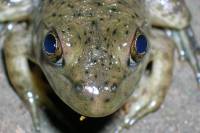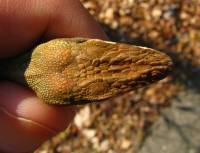Table of Contents
Parietalauge

Viele Echsen, Amphibien und Fische besitzen ein Parietalauge oder Scheitelauge. Wie ein normales Auge besteht es aus Linse und Netzhaut, besitzt aber keine Iris. Es sitzt mitten auf Stirn, meist unter einer durchsichtigen Schuppe verborgen. Besonders gut ist es bei grünen Leguanen und Bartagamen zu sehen. Über die Lücke (Parietalforamen) zwischen den beiden Knochen des Scheitelbeins ist es mit dem Gehirn verbunden. Man geht davon aus, dass das Auge in der Evolution als Paar angelegt war. Das linke Auge ist nach vorne gewandert und heute bei einigen Tieren als Parietalorgan vorhanden, das rechte Auge nach hinten und bildet das heutige Pinealorgan vieler Tiere.
Von den Wirbeltieren ist das Parietalauge bei den Echsen am weitesten entwickelt. Alle untersuchten Echsen besitzen ein Pinealorgan, nicht alle ein Parietalauge [190Ellis-Quinn, B. A., & Simony, C. A. (2004). Lizard homing behavior: the role of the parietal eye during displacement and radio-tracking, and time-compensated celestial orientation in the lizard sceloporus jarrovi. Behavioral Ecology and Sociobiology, 28(6), 397–407.].

Parietalauge und Thermoregulation
Parietalauge und Orientierung
Viele Tiere haben ein festes Revier in dem sie einen großen Teil ihres Lebens verbringen. Entfernen Sie sich aus ihrem Revier sind sie normalerweise sehr gut in der Lage wieder nach Hause zurück zu kehren. Echsen, die etwa 200 m von ihrem Fangort entfernt wieder ausgesetzt werden (und während des Transports ihre Umgebung beobachten können) laufen in der Regel schnell und auf direktem Weg wieder in ihr Revier zurück (zum Vergleich: Das Revier hat etwa einen Durchmesser von 15 m).
Bei Echsen wurde untersucht, wie stark das Parietalauge in diesen Prozess eingebunden ist [190Ellis-Quinn, B. A., & Simony, C. A. (2004). Lizard homing behavior: the role of the parietal eye during displacement and radio-tracking, and time-compensated celestial orientation in the lizard sceloporus jarrovi. Behavioral Ecology and Sociobiology, 28(6), 397–407.]. Stachelleguane (Sceloporus jarrovii) wurden eingefangen und in drei Gruppen unterteilt.
- Einer Gruppe wurde das Parietalauge mit Farbe zugedeckt (“exp”).
- Eine Gruppe erhielt Farbe neben das Parietalauge (“sham”).
- Eine Gruppe wurde nicht behandelt (“normal”).
Die Tiere wurden zwei Tage lang beobachtet. Die Echsen mit verdecktem Parietalauge irrten zwei Tage lang ziellos in der Gegend in der sie ausgesetzt wurden herum. Die beiden anderen Gruppen liefen hingegen zielstrebig und auf direktem Weg wieder nach Hause und waren nach zwei Stunden wieder in ihrem Revier angekommen.
In einer anderen Arbeit wurden Tannenzapfenechsen (Tiliqua rugosa) gefangen und 800 m weit entfernt wieder ausgesetzt [200Freake, M. J. (2001). Homing behaviour in the sleepy lizard (tiliqua rugosa): the role of visual cues and the parietal eye. Behavioral Ecology and Sociobiology, 50(6), 563–569.]. Dabei wurden drei Szenarien vergleichen.
Im ersten Experiment wurden die eine Hälfte der Tiere in einem geschlossenen Beutel die andere Hälfte offen in der Hand transportiert. Die Tiere, die offen transportiert wurden, konnten sich den Rückweg merken und fanden schnell wieder in ihr Revier zurück (7 von 11 Tieren waren nach 8 Tagen wieder in ihrem Revier). Von den 10 Tieren, die in geschlossenen Beuteln transportiert wurde, fand keines in sein Revier zurück.
Im zweiten Experiment wurde die Hälfte der Tiere in der Hand transportiert, die andere Hälfte in einer oben offenen Kiste. Diese zweite Gruppe hatte zur Orientierung also nur das Himmelslicht zur Verfügung und konnte sich nicht an der Landschaft orientieren. Hier gab es keine Unterschiede zwischen den beiden Gruppen. Die Echsen sind also nicht auf die Landschaft als Orientierung angewiesen sondern finden allein über die Information des Sonnenlichts die richtige Richtung.
Im letzten Experiment wurden beiden Gruppen das Parietalauge mit Leukoplast und Alufolie verdeckt, bei der Hälfte der Tiere enthielt die Alufolie jedoch ein 1,5 cm großes Loch direkt über dem Parietalauge. Die Tiere wurden offen transportiert, beide Gruppen konnten also mit den Augen Himmel und Landschaft beobachten. In diesem Experiment fanden nur die Tiere, deren Parietalauge unverdeckt war, wieder nach Hause. Obwohl die Tiere mit abgeklebtem Parietalauge die Landschaft und den Sonnenstand mit ihren Augen sehen konnte, hat das nicht zur Orientierung ausgereicht.
Parietalauge und Greifvögel
Literatur
[190] Ellis-Quinn, B. A., & Simony, C. A. (2004). Lizard homing behavior: the role of the parietal eye during displacement and radio-tracking, and time-compensated celestial orientation in the lizard sceloporus jarrovi. Behavioral Ecology and Sociobiology, 28(6), 397–407.
[200] Freake, M. J. (2001). Homing behaviour in the sleepy lizard (tiliqua rugosa): the role of visual cues and the parietal eye. Behavioral Ecology and Sociobiology, 50(6), 563–569.
[294] Adler, K. K. (1976). Extraocular photoreception in amphibians. Photochemistry and Photobiology, 23(4), 275–298.
[403] Aggelopoulos, N. C., & Meissl, H. (2000). Responses of neurones of the rat suprachiasmatic nucleus to retinal illumination under photopic and scotopic conditions. Journal of Physiology, 1, 211–222.
[774] Beltrami, G., Bertolucci, C., Parretta, A., Petrucci, F., & Foà, A. (2010). A sky polarization compass in lizards: the central role of the parietal eye. Journal of Experimental Biology, 213, 2048–2054.
[529] Brainard, G. C., Barker, F. M., Hoffman, R. J., Stetson, M. H., Hanifin, J. P., & Podolin, P. L., et al. (1994). Ultraviolet regulation of neuroendocrine and circadian physiology in rodents. Vision Research, 34(11), 1521–1533.
[212] Carrillo-Vico, A., Guerrero, J. M., Lardone, P. J., & Reiter, R. J. (2005). A review of the multiple actions of melatonin on the immune system. Endocrine, 27(2), 189–200.
[398] Crumly, C. R. (1982). The "parietal" foramen in turtles. Journal of Herpetology, 16(3), 317–320.
[194] Engbretson, G. A., & Hutchison, V. H. (1976). Parietalectomy and thermal selection in the lizard sceloporus magister. Journal of Experimental Zoology, 198(1), 29–38.
[773] Engbretson, G. A., & Lent, C. M. (1976). Parietal eye of the lizard: neuronal photoresponses and feedback from the pineal gland. Proceedings of the National Academy of Sciences, 73(2), 654–657.
[469] Foà, A., Basaglia, F., Beltrami, G., Carnacina, M., Moretto, E., & Bertolucci, C. (2009). Orientation of lizards in a morris water-maze: roles of the sun compass and the parietal eye. Journal of Experimental Biology, 212(2918), 2924.
[494] Foster, R. G., & Soni, B. G. (1998). Extraretinal photoreceptors and their regulation of temporal physiology. Reviews of Reproduction, 3(3), 145–150.
[205] Hamasaki, D. I., & Dodt, E. (1969). Light sensitivity of the lizard's epiphysis cerebri. European Journal of Physiology, 313(1), 19–29.
[290] Hamasaki, D. I., & Eder, DJ. (1977). Adaptive radiation of the pineal system. In F. Crescitelli (Ed.), The Visual System in Vertebrates (pp. 497–548).Springer.
[380] Hartwig, H. G., & van Veen, T. (1979). Spectral characteristics of visible radiation penetrating into the brain and stimulating extraretinal photoreceptors. Journal of Comparative Physiology A, 130(3), 277–282.
[189] Hutchison, V. H., & Kosh, R. J. (1974). Thermoregulatory function of the parietal eye in the lizard anolis carolinensis. Oecologia, 16(2), 173–177.
[491] Innocenti, A., Bertolucci, C., Minutini, L., & Foa, A. (1996). Seasonal variations of pineal involvement in the circadian organization of the ruin lizard podarcis sicula. Journal of Experimental Biology, 199(5), 1189–1194.
[523] Jenison, G., & Nolte, J. (1980). An ultraviolet-sensitive mechanism in the reptilian parietal eye. Brain Research, 194(2), 506–510.
[187] McKeehan, A., & Sievert, L. M. (1996). The effect of shielding the parietal eye of podarcis muralis on behavioral thermoregulation. Journal of Thermal Biology, 21(5-6), 397–401.
[206] Meissl, H., & Ueck, M. (1980). Extraocular photoreception of the pineal gland of the aquatic turtlepseudemys scripta elegans. Journal of Comparative Physiology A, 140(2), 173–179.
[191] Phillips, J. A., & Harlow, H. J. (1981). Elevation of upper voluntary temperatures after shielding the parietal eye of horned lizards (phrynosoma douglassi). Herpetologica, 37(4), 199–205.
[192] Phillips, J. A., & Howes, K. A. (1988). The pineal complex, aggressive behavior and thermoregulation in curly-tailed lizards, leiocephalus carinatus. Physiology & Behavior, 42(1), 103–108.
[204] Ralph, C. L., Firth, B. T., & Turner, J. S. (1979). The role of the pineal body in ectotherm thermoregulation. American Zoologist, 19(1), 273–293.
[530] Ramachandran, A. V., & Ndukuba, P. I. (1988). Preliminary evidence for pineal-mediated extraretinal photoreception in relation to tail regeneration in the gekkonid lizard, hemidactylus flaviviridis. Journal of Pineal Research, 6(2), 121–134.
[193] Roth, J. J., & Ralph, C. L. (1976). Body temperature of the lizard (anolis carolinensis): effect of parietalectomy. Comparative Physiology and Biochemistry, 198(1), 17–28.
[67] Sarkar, S., Sengupta, A. S. S., Chaudhuri-Sengupta, S., & Maiti, B. R. (2007). Thyroid responses to altered photoperiod in the soft-shelled turtle lissemys punctata punctata bonnaterre. Acta biologica Hungarica, 58(1), 11–19.
[772] Stebbins, R. C., & Eakin, R. M. (1958). The role of the "third eye" in reptilian behaviour. american museum novitates, 1870, 1–40.
[401] Stumpf, W. E. (1988). The endocrinology of sunlight and darkness. Naturwissenschaften, 75(5), 247–251.
[463] Su, C.-Y., Luo, D.-G., Terakita, A., Shichida, Y., Liao, H.-W., & Kazmi, M. A., et al. (2006). Parietal-eye phototransduction components and their potential evolutionary implications. Science, 311(5767), 1617–1621.
[188] Tosini, G., & Avery, R. A. (1994). Occlusion of the parietal eye induces a transient wavelength-dependent shift in lizard thermoregulatory set points. Journal of Experimental Zoology, 1(1), 84–87.
[395] Tosini, G., & Menaker, M. (1996). The pineal complex and melatonin affect the expression of the daily rhythm of behavioral thermoregulation in the green iguana. Journal of Comparative Physiology A, 179, 135–142.
[394] Tosini, G. (1997). The pineal complex of reptiles: physiological and behavioral roles. Ethology Ecology & Evolution, 9, 313–333.


Discussion